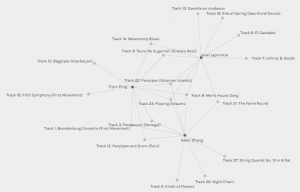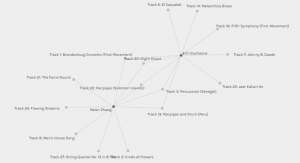Task 9 Network assignment

I’m using the newer GoldenRecordB file for the analysis and reflection. In this file, I’m in community 3 with Junel and Yijun.
Link to Junel’s justification: https://blogs.ubc.ca/missjunetexttechnology/tasks/
Link to Yijun’s justification: https://blogs.ubc.ca/etec540trista/2022/07/09/task-8-golden-record-curation-assignment/
We have selected many instrumental songs, but due to different reasons. I focus on minimizing the possibility of aliens misinterpreting the lyrics. On the other hand, Yijun thinks lyrics are redundant to the “Greetings from Earth” track, so they do not need to be included. Nevertheless, we still share similar reasoning. The pieces of music we choose are created by musicians with different cultural backgrounds. And we make these choices because our goal is to include “diverse” music and be “inclusive”. However, does it mean people in other communities are not being “as inclusive as possible” as Carl Sagan would like to see (Twenty Thousand Hertz, n.d.)?
Motivated by curiosity, I have randomly selected another classmate from community 4, Erin. I quickly realized that Erin picked a variety of songs as well. The graph fails to reveal that we have the same goal to be inclusive. And it surprises me that although Erin and I are not grouped in the same community, we still share 5 vertices. Note I only have 5 and 4 vertices in common with Yijun and Junel, respectively. It is demonstrated that the graph is unique because of everyone’s presence and everyone’s choice. For example, if Yijun and all community 4 members did not select their 10 songs, I will be grouped with Erin, not Junel, since Erin and I have more connected edges (Palladio, n.d.).

The discovery inspires me to think about communities and social networks in the physical world. The communities are also shaped by both people inside and outside. People usually form a community or are perceived as a community based on similar ideologies and characteristics. However, they may have more similarities and connections with people outside the small circle than we think. In addition, the environment, people, and behavior form a system of triadic reciprocal causation as Social Cognitive Theory proposes (Bandura, 2011), which continuously changes the boundary of communities. In other words, communities are neither isolated nor fixed. Computer algorithms with no temporal information only capture a snapshot of the community ecosystem (e.g. association in LinkedIn) but fail to demonstrate the richer messages behind the shifts in time.
It would also be interesting to explore the notion of community in a weighted graph. If we were asked to rearrange the 10 songs instead of listing them, the orders can be assigned to the edges as the weight. The resulting graph may be a more comprehensive model showing our underlying assumptions about what is the most important thing that we can afford to keep.
References:
Bandura, A. (2011). Chapter 17: Social cognitive theory. In P. A. M. van Lange, A. W. Kruglanski, & E. T. Higgins (Eds.), Handbook of Social Psychological Theories, 349-373. London: Sage.
Palladio. (n.d.). Create a facet filter. Stanford. http://hdlab.stanford.edu/palladio/tutorials/facet/
Twenty Thousand Hertz. (n.d.). Voyager Golden Record. [Audio podcast episode]. Megaphone. https://cms.megaphone.fm/channel/20k?selected=TTH4214315391